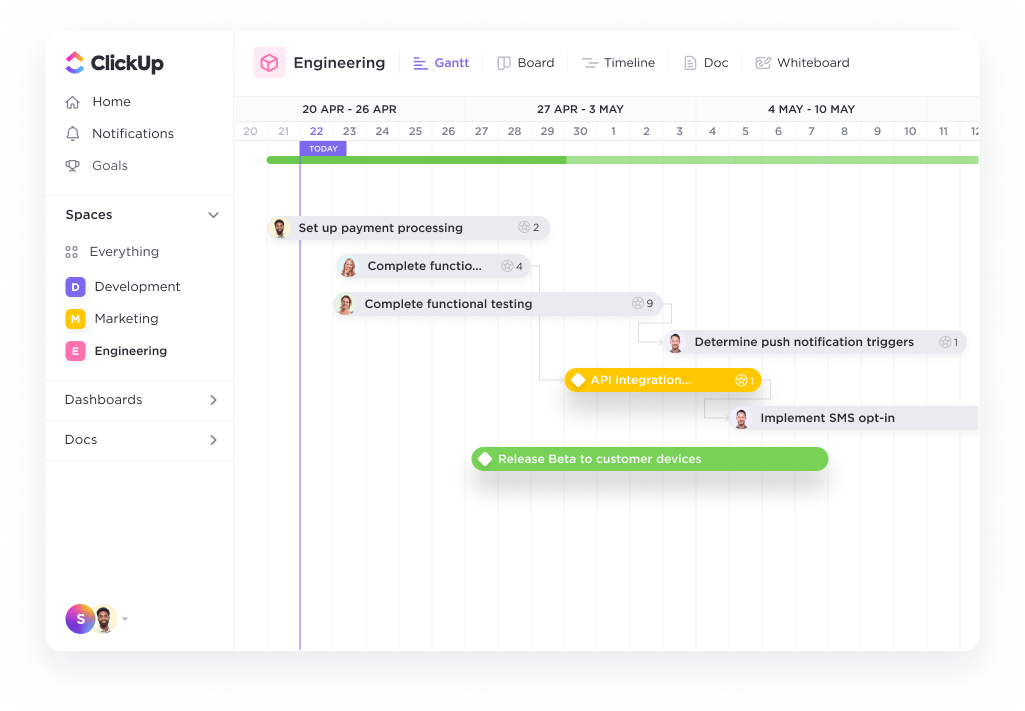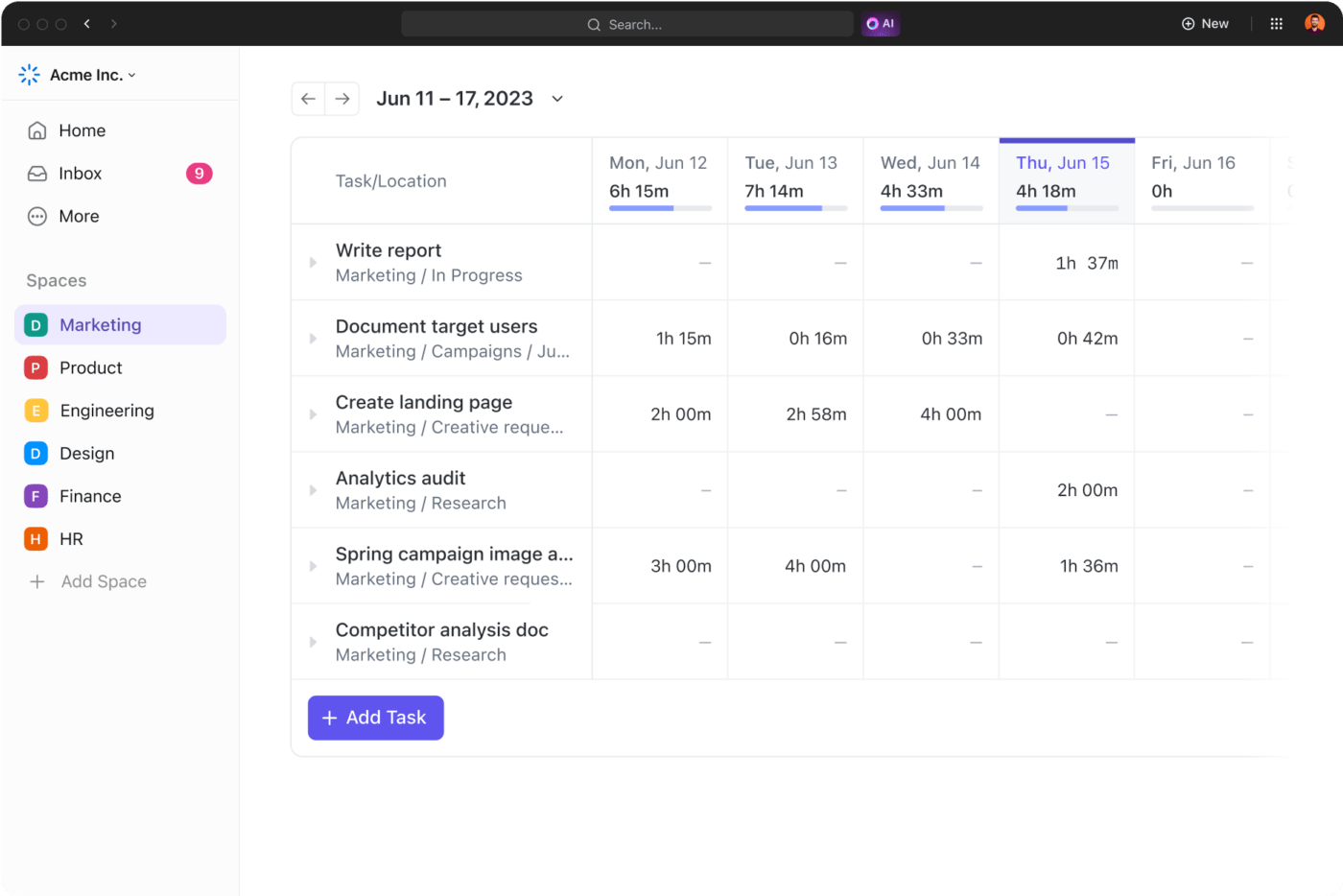How to Use Critical Chain Project Management Effectively

Sorry, there were no results found for “”
Sorry, there were no results found for “”
Sorry, there were no results found for “”
Imagine if project management were as simple as checking off a to-do list—quick and done.
In reality, launching a product or adding software features is far more complex. One minor roadblock can create unexpected delays down the line.
To successfully execute real-world projects, you need to prioritize tasks, find efficient ways to complete them, and build in time for unexpected disruptions. ⏳
That’s where Critical Chain Project Management (CCPM) comes in.
But what does this approach mean? What are its fundamentals? How can you use it to improve project scheduling, resource allocation, and overall workload management efficiency?
This blog post will answer all your questions and more.
CCPM is a project management technique that emphasizes efficient resource utilization—people, equipment, and physical space—to execute project tasks successfully. Introduced in 1997 by business management expert Eliyahu M. Goldratt in his book Critical Chain, this approach serves as a roadmap for projects that often face delays or go over budget.
Key elements of this technique include:
Understanding the difference between the critical chain and critical path methods is key to effective project management. It directly affects how you allocate resources and manage timelines.
The critical chain method emphasizes the resources necessary to complete a project efficiently. As a project manager, you strategically add extra resources as buffers to mitigate potential disruptions. Your project stays on track if these buffers remain unused, indicating successful progress.
Conversely, in the critical path method, you focus on a single sequence of the most crucial project tasks. The goal is to design an ideal workflow to finish the tasks within the project timeline and remove non-essential tasks from your priority list.
Additionally, the Project Management Institute advocates for the critical path method as a powerful project management technique that can further enhance project progress by concentrating on the most critical activities within the project network.

Traditional project management methods often emphasize fixed timelines and a linear approach, which can lead to delays. Unlike those, the critical path project management approach emphasizes the importance of task dependencies and critical resources, allowing teams to identify the critical tasks that will impact the overall project duration.
Both these project management methodologies are designed to be more efficient than traditional ones. However, while the critical path focuses on project scheduling, the critical chain focuses on the essential resources you need.
💡Pro Tip: Use critical path analysis software to manage complex projects with visual dependency representation, scenario analysis, and resource allocation features to manage complex projects with interconnected tasks and timelines.
With the critical chain method, project managers can effectively manage project schedules and account for resource constraints, leading to successful project completion. This methodology comprises six main components that are essential for its effectiveness. They are:
The core idea in CCPM is that every project has a critical chain—the longest sequence of dependent tasks considering task dependencies (like which tasks must be completed before others can start) and resource availability.
Your primary focus should be managing this critical chain to optimize project progress and minimize delays due to bottlenecks.
For example, in a product development project, your critical chain includes product design, prototyping, development, quality assurance, and testing, all of which rely on a limited number of specialized team members.
Delays in these activities can derail the entire project, so it’s crucial to ensure that each task flows smoothly into the next.
There are three types of project buffers in critical chain project management.

This buffer is added at the end of the critical chain to prevent missing deadlines caused by delays in essential tasks.
For instance, in a construction project, you might place a project buffer after critical chain activities such as laying the foundation and structural framing.
Feeding buffers are added at points along the critical chain where non-critical tasks enter the main flow. This prevents any delays in those non-critical tasks from affecting the overall deadline.
Going ahead with the construction project example, you can add feeding buffers for non-critical activities like landscaping.
A resource buffer alerts you to prepare extra resources in advance to avoid delays due to resource constraints. Such buffers are essential in projects using highly specialized or hard-to-source resources.
So, if your construction project involves a particular type of earthquake-resistant scaffolding, you must set up a resource buffer to ensure this scaffolding is completed on time.
ClickUp’s Critical Pathway Analysis (CPA) Template makes it easy to map out the tasks essential for project success, pinpointing where to place these buffers and how much buffer time is needed.
This ready-to-use framework offers the tools needed to identify critical paths and gain visibility into potential challenges while managing projects of varying complexities. It streamlines decision-making by providing a clear roadmap that considers all possibilities.
This template allows you to:
With this template, you can track buffer consumption in real time, enabling you to take corrective actions before delays impact your project’s timeline.
When optimizing resource allocation for the project, make sure the right people and tools are available for all critical chain tasks at the right time.
When two teams require the same resource, prioritize the critical tasks to maintain productivity.
For example, the application development team should prioritize database connectivity issues affecting critical functionality over misaligned graphics on the app’s landing page.
This is important because if users can’t access essential features due to connectivity issues, it can lead to frustration, decreased satisfaction, and potential customer loss.
In contrast, misaligned graphics are important for aesthetics but don’t hinder the application’s core operations.
💡Pro Tip: Use the ClickUp Resource Allocation Template to get a complete overview of resource availability and allocate resources according to individual task requirements and priorities.
You can review the tasks and resources and then prioritize using Custom Fields. Bring your plan to life by visualizing the completion sequence with the ClickUp Gantt Chart View, making it easy to track progress and stay on top of your project!

ClickUp Workload View helps you visualize each team member’s workload against the team’s collective work capacity. With color-coded weekly, bi-weekly, and monthly views, you can quickly spot overworked and underutilized employees, making it easy to reallocate tasks for optimal resource utilization.

With the ClickUp Project Time Tracking feature, you can track your team’s time on tasks versus the estimated time. You can see the total hours spent on each task and subtask. You can filter, categorize, and group tasks to create custom reports for stakeholders, helping you assess whether the current resource allocation plan keeps the project on track to meet its goals.

Step into the scenario: What would you do?
Scenario 1: New resource availability
You have access to a new resource that could expedite a critical task but comes with a learning curve. Do you:
A) Integrate the new resource immediately to speed up the process
or
B) Wait until the team is trained before integrating the new resource
Potential outcome:
A) Integrating the resource immediately may lead to initial inefficiencies but could accelerate project completion in the long run.
B) Waiting for training ensures quality and efficiency but may delay the project timeline.
In critical chain project management, a good rule of thumb is to set task durations with a 50% confidence level. This estimate assumes a 50% chance of completing the task within the given time frame, so it’s not overly conservative or padded with safety margins.
The approach encourages your team to work more efficiently and deliver tasks ahead of schedule.
For example, if your team typically finishes a marketing campaign task in two weeks but often includes extra time “just in case,” under this method, you’d set the task time to one week (the 50% confidence estimate) and rely on a one-week buffer to absorb any delays if they occur.
As a critical chain project manager, monitoring buffer consumption throughout the project’s progress and making necessary adjustments is essential. Resource buffers and project buffers are vital components of the critical chain methodology, ensuring that dependent tasks are completed on schedule, even when unforeseen issues arise.
For instance, if you notice that your buffers in the integration testing phase of a project are being consumed faster than expected due to unexpected challenges in the unit testing phase, you can allocate additional resources to speed things up or adjust the overall project plan to prevent further delays.
ClickUp’s Critical Pathway Analysis Template offers ongoing insights into your project’s current status and clearly outlines the timely actions for successful completion. It also defines the tasks that can be delayed, allowing you to effectively reallocate resources to catch up on missed or overrunning tasks.
The template’s Doc view helps teams organize task information and resources in a centralized location. It also allows teams to interact in real time or asynchronously, ensuring no details are overlooked.
This level of transparency enhances collaboration, as team members can define the critical path together, share ideas and insights, and provide feedback to keep the project moving.
As we’ve explained, prioritizing one task at a time is more conducive to CCPM than multitasking. Getting the same designer or engineer to cover multiple deliverables simultaneously will only slow them down and increase the chance of mistakes.
Instead, assign them to one task at a time so that they can devote all their focus to it.
For instance, you can plan the next steps with ClickUp Task Priorities. Choose any of the four flags, Urgent, High, Normal, and Low, and set filters for due dates so that your team knows exactly what to focus on and when.

You can also take control of your notifications and customize them like never before with ClickUp Notifications.
Your team will be alerted automatically when they need to start a task, when a task is nearing its deadline, or when priorities shift. Any action in ClickUp can trigger a customized notification, helping you make progress with your project hassle-free.

Tracking and organization of company projects is very easy and effective with ClickUp software. From simple lists to complicated projects, ClickUp software has been used to get things done as expected. It is a very effective software when addressing task management problem and tracking the progress of organization ongoing tasks and projects.
Step into the scenario: What would you do?
Scenario 2: Task duration estimation
You have a project with a critical task estimated to take two weeks. Team members suggest it may take longer due to potential obstacles. Do you:
A) Stick to the original estimate to meet the deadline
Or
B) Extend the duration and adjust the buffer accordingly
Potential outcome:
A) Sticking to the original estimate may lead to rushed work and a failure to meet deadlines.
B) Extending the duration allows for thorough work, increasing the likelihood of on-time completion, assuming you adjust your buffers properly.
Navigating task duration estimates is crucial in CCPM; your choices can significantly impact project success.
Let’s examine how to effectively implement the critical chain method in project management and ensure that all tasks stay on track.
As the critical chain project manager, clearly define the project scope and objectives. Then, get everyone on the same page about your expectations of each team member.
For example, if the goal is to launch a new software feature within six months, ensure the entire team understands what that feature accomplishes and how it fits into the software product.
Next, use the ClickUp Task Dependencies feature to map independent and interconnected tasks on a network diagram. You can also determine which tasks are ‘waiting on’ or ‘blocking’ others with dependencies.

The ClickUp Gantt Chart View helps visualize all tasks and their dependencies. The feature lets you drag and drop tasks, monitor the critical path and slack time, adjust timelines, and immediately see how changes affect the overall project.

You can also unite your ClickUp Tasks, Spaces, Folders, and Lists in one place and color code your Gantt chart for easy identification. Celebrate milestones with real-time updates and progress percentages.
Based on your project dependency mapping, identify the critical chain—the sequence of tasks most limited by resource availability and task dependencies. These tasks will most likely delay the project timeline if not handled properly.
Leverage the neural network of ClickUp Brain, ClickUp’s AI-powered assistant, to help you identify the critical chain in your project and give you the right insights into critical chain methodology.
Add your query as a prompt, and you will get the answer immediately.
For example:

The next step is to add buffers along the critical chain strategically. Begin by placing a buffer at the end to avoid delays that could jeopardize your deadline.
For example, if you’re developing a new product, add a buffer for last-minute packaging or quality issues. Also, buffers should be included where non-critical tasks connect to the critical chain to mitigate any potential delays from those tasks.
With buffers in place, it’s time to create a project schedule based on the most realistic durations for each task. Set deadlines without inflated safety margins—your buffers are designed to accommodate setbacks.
Your goal is to keep the project moving smoothly and to ensure your team members focus on one task at a time. With ClickUp Project Management, organizing tasks and managing resources becomes easy, helping your team confidently hit every milestone.
In addition to gaining consensus faster and kickstarting projects with clarity across stakeholders, you get:

After the project launch, monitor progress closely, paying particular attention to buffer consumption patterns.
As the project manager, be prepared to be flexible at any time. Let’s say, for instance, that your design agency suddenly wants to renegotiate its contract during your marketing campaign project because of scope creep.
You’ll need to be ready to shift resources or find a new design team to avoid missing the campaign deadline.
To do a complete retrospection at the end of the project, ask yourself these questions:
Understanding what worked and didn’t is vital for improving your approach to future projects.
Use ClickUp Dashboards to visualize everything from the outcomes of marketing campaigns to the expenses and revenue metrics of a software development project. Visualizing data through pie charts, bar graphs, and flow charts helps identify patterns and areas for improvement.
One of the most frequent pitfalls teams encounter is underestimating the time to complete tasks. This often results in rushed timelines and missed deadlines, frustrating everyone.
Corrective action ✅ : To combat this, implement regular assessments of task durations by leveraging historical data and gathering input from your team. Encourage everyone to share their insights on realistic timeframes—this fosters accountability and empowers your team to take ownership of their timelines.
Another common misstep is not adjusting buffer sizes as the project progresses. Ignoring real-time data can result in delays when unexpected challenges arise, throwing the entire project off track.
Corrective action ✅ : Establish a routine for reviewing and adjusting buffers at project milestones. Encourage your team to document lessons learned from past projects, using this knowledge to inform future buffer adjustments. This proactive approach can significantly enhance your project’s resilience.
Effective communication is vital for successful CCPM implementation. Unfortunately, a lack of communication can lead to misunderstandings about priorities and deadlines, ultimately derailing your efforts.
Corrective action ✅ : Schedule regular check-ins to discuss progress, address concerns, and reiterate project goals. Create an open communication culture where everyone feels comfortable sharing their thoughts. This alignment will help your team stay focused and engaged throughout the project lifecycle.
Your project’s success hinges on how you execute it. With the CCPM approach, you can zero in on the most critical activities and ensure that your resources are perfectly aligned—ready in the right quantities and at the right time.
When you integrate these methodologies with a robust project management tool like ClickUp, you’ll streamline your workflow and unlock your project’s full potential.
Whether you opt for the critical chain method or critical path templates, ClickUp will elevate your project planning and execution, empowering your team to achieve new heights of efficiency and value.
What’s holding you back? Make the most of the platform! 🌟
Sign up for ClickUp for free today.
© 2025 ClickUp